![]() >> Sonja's Latest work By Sen + Sonja Drawing Flash Made in 2006 > The Medium A tour via thumbnail images
>> Sonja's Latest work By Sen + Sonja Drawing Flash Made in 2006 > The Medium A tour via thumbnail images

Above: Performance outside
the London Stock Exchange.
Photo: Annabel Knight, U.K.
For the
Change is a law of nature performances
I informed people that I had currency to trade and presented them with a palette-shaped tray
on which there were 5 plastic coins
(in shades of translucent grey).
Commission by the
U.K. Hull Time-based Arts
for their performance festival Skint, October 1996.
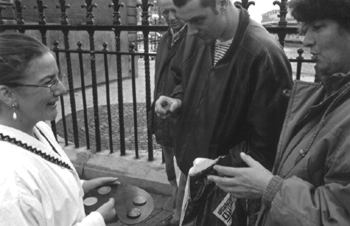
Change is a Law of Nature, Hull, U.K.
photo: Andy Locke, U.K.
Most people took a coin in their hands and looked at it and fiddled with it while we talked.
My job was to convince them that this currency had some worth.
Although it appeared that I was encouraging them to buy or trade with me, what I was really doing was getting them to consider the issue of ´value´ or ´values´.
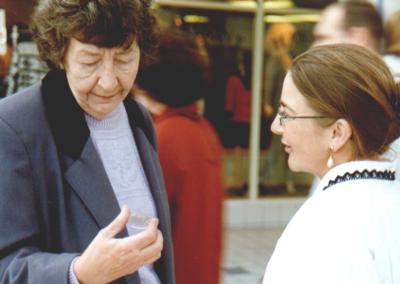
|
And in this case their own contribution to this process (the price was what they offered and I then considered that and talked about whether what they had offered was fair or representative). | ||||||||||||||||||||||||||||||||||||||||||||||||||||||||||||||||||||||||||||||||||||||||||||||||||
| What they really were valuing was the trust they developed in me -the artist and through that the art object. And that was the concept behind the whole thing. That value or values are based on how much we trust the produce, and in the art world the produce is really the artist's act, not the paint. I focused on these coins as ´art´ (and hence of the spirit/ aesthetic) during these exchanges, and this highlighted the moral dimension of commerce, rather than making fun of ´originality´ or ´value´. | 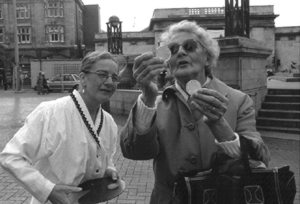
|
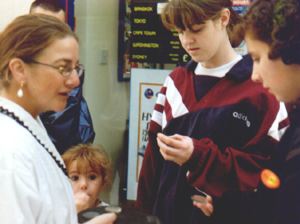
|
"Commerce is as a heaven, whose sun is trustworthiness and whose
moon is truthfulness" Bahá'u'lláh (Compilation on Trustworthiness) I was focussing on the relevance of art (money) and about what happens during a transaction and the implied values that go with this, to reflect not only on the evitability of change but to see that it's not such a bad thing. | ||||||||||||||||||||||||||||||||||||||||||||||||||||||||||||||||||||||||||||||||||||||||||||||||||
|
One aspect of these exchanges was that currency
became a memento of change and exchange itself rather than only
a means of trade.
Now these sound like lofty ideas, but you might wonder how did it really work with people not 'in' on my story. Well, we talked (engaged), and I mostly asked questions to direct them into thinking about these things and into giving me their own opinions on the value of things, beginning often with the lack of money. |

|
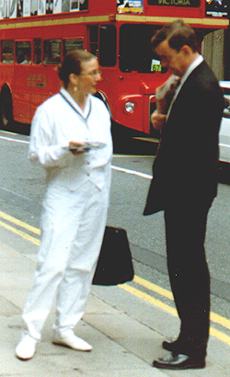
|
I was stunned by the receptiveness of people,
and it was a great learning experience as well as a lot of fun.
People's faces, after the initial unease, would light up, and they
really wanted to trade with me, because they valued 'values', not
just because of the piece
of plastic in their hands.
I made this piece partly in response to the Maastricht Treaty where free trade and a common currency among the EEC countries were two items agreed upon. Living in this city at the time and thinking about these issues, I thought, why not make an art currency whose value is changing and is based on human interaction rather than the idea of some standard form. In a sense these coins can be seen as some sort of universal currency in that the only clearly cultural characteristic is the English text. Yet in another way they are hardly universal in that their individual value is dependent on particular cultural circumstances. | ||||||||||||||||||||||||||||||||||||||||||||||||||||||||||||||||||||||||||||||||||||||||||||||||||
|
Maastricht is a provincial city at the periphery of Dutch decision-making,
where there is a pride in their own language and distinctive Limburg
culture.
However, at the same time, there is an awareness that the province of Limburg is seen as backward and remote by the majority of Dutch residents who live in the west. It is this type of nationalism that hinders many countries, nations, internally and externally. | 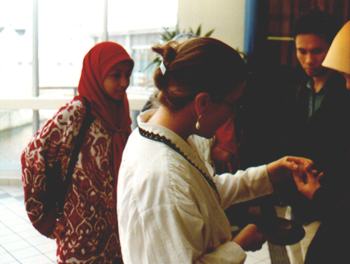
|
|
|
I believe that an auxiliary currency (whether of language or of money) is necessary to facilitate communication (and we have it whether we like it or not, say in the power of the Deutschmark which influences other European currencies) and it is healthier to decide on this as an auxiliary, rather than leave it to the majority becoming the deciding factor, where strange ideas such as cultural superiority might come into play. The shades of grey (in the colour of the coins) refers not just to the complexities of identity and nationalism, but also to my belief that there isn't a particular superior or pure race or colour or answer. One reason for mixing the idea of money with ethics in my performances was to get people to think about their own responsibility or engagement in this process, not only to do with nationalism or identity, but also to do with daily transactions. | ||||||||||||||||||||||||||||||||||||||||||||||||||||||||||||||||||||||||||||||||||||||||||||||||||
|
We all need a sense of the myth, romance, the positive or the human,
in order to work through our own disappointments, fears or ignorance. I hope that my change coins bring a smile, some small change perhaps? |
| ||||||||||||||||||||||||||||||||||||||||||||||||||||||||||||||||||||||||||||||||||||||||||||||||||
In conversation with Johannes Birringer, U.S.A. |
Change is a Law of Nature,
|
Sonja: That's what it was all about. It was scary, because on one hand I was really performing, and not following some script. |
What was interesting is that a number of people asked if it would bring them luck.
I told them it would bring them whatever they felt it would bring, but that it didn't have any magical powers in itself.
With some it was clear that they had decided that it was some sort of lucky charm anyway. I didn't mind.
It was better than buying an art work for investment, and at least this would be meditated on for what
it could manifest rather than for what amount of money it could bring in.
|
Change is a Law of Nature, Hull, U.K.
|
My longest and most memorable exchange was with another artist. His approach to me was to make a fake performance of what I was doing. In one sense as we
argued and debated, I saw his point, that his art was faking and to offer this was a fair trade. On the other hand I wanted to get beyond his art to him, the person, and it happened in a remarkable way!
|
Change is a Law of Nature,
| His first tactic was to offer me quotations by famous authors about trading as a trade for the coin. At first I refused on the grounds that it had to have a physical characteristic to be a fair trade, since he was constantly handling and fiddling with the coin. Then he dramatically put the coin on the ground and stood on it, pressing it into a layer of cake icing (an artwork we were both standing on at the time) claiming that in the name of everything since Fluxus or Duchamp we didn't need the coin anymore. I retrieved it from out of the icing and claimed that without the coin, we wouldn't have a grip on the physical, a real part of ourselves. During the hour or more conversation onlookers, added their bit and moved away adding to the whole exchange. In the end we agreed to lease the coin for something of his. He changed and started thinking of what could he offer, instead of what he could trick me into accepting -at least that was my perception. |
As he searched over his body for pockets and things, I pointed to his ring covered
fingers. His face lit up. He pulled off the ring from his little finger and said "yes, it had to be this
one". He then asked me to read the inside, which read 'together forever' in French, and then he proceeded to tell me a long story about how it had belonged to his father who had found it as a boy. It
seemed to be an old ring, but since his art was creating a fake history for objects, I wasn't sure about the story, but that gaze in his eyes told me he knew, as painful as it was, that this was a suitable trade, and
I felt it too, even though I didn't really want to wear a bulky ring on my finger.
|
About three hours later, he came to me with his daughter and
said that against his wishes we had to trade the items back because
his daughter was getting more upset.
|

Change is a Law of Nature, Hull, U.K.
|
Johannes: Well, you probably don't look like a terrorist or an intimidating person, so they may be willing to offer a little bit more trust, or time. If you had dark skin and a beard, you may be more suspect. People would pretend to not see you. |
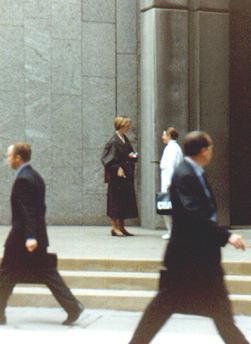
Change is a Law of Nature,
|
Sonja:
You are right. And outside the London stock exchange they did
perceive me like a beggar and so it was extremely different to make
contact but I wouldn't have had a chance if I'd been wearing jeans.
|
That was also the reason why it was important to me to do this performance here, outside the London Stock Exchange on a Monday morning. It was scary and difficult but I did because -for me- it was a way of extending myself beyond the perimeters of the performance festival in Hull. |
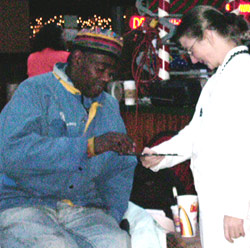
Change is a Law of Nature, 2001, in the Santa Monica main shopping street at Christmas time. |
Johannes: I wonder whether anyone you talked with had any sentiments or opinions on
xenophobia? on "CHANGE" as a concept, or on changing values. What did they
offer you, money, other objects, affection, laughter?
|
|
Sonja: I considered the offer of a kiss as sexist. The young man even bent down as if he was sure I would agree just because he offered it. |
Johannes: Did anybody want to take one of your grey coins?
|
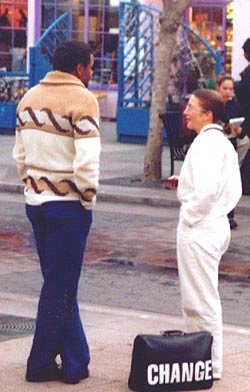
Change is a Law of Nature, |
Johannes: How do we "deal" with the other. Did the people you "dealt" with deal with
you, the costumed artist/vendor, interloper in public spaces? Oh, you
didn't have a proper permit?
Sonja: Well at times people crowded around me (probably because of the
sight of tv cameras) and in one
instance 2 security men from a shopping centre came to break up the
conservation we were engaged in, to say that we were blocking the
entrance and had to move on. I asked them to wait and finished the
deal and then asked how? |
Change is a Law of Nature, |
Change is a Law of Nature, |
Sonja: So. yes Johannes, I didn't really challenge any 'border' since I was legitimitized as part of the festival for some people I interacted with.
Also I wasn't aiming to challenge a barrier/border in that sense. I didn't want people who I approached to be part of that either. So yes, it had to seem ok, at first glance, that I was not doing anything illegitimate, which was
another reason for wearing presentable non-challenging clothing and introducing myself politely to people. If anyone showed signs of discomfort, I left them alone.
|
|
Sonja: This point came up a lot with my interactions in the U.K with non-artists. A lot of people associated the euro with a loss of their identity, rather than as an auxillary. Interesting, in the
Netherlands people aren't worried about losing anything with the Euro, even the gulder is set against the more or less stable DM, which is likely to lose some value with the birth of the euro.
But I think this touches something deeper. The Dutch are on the whole, travellers/tradespeople and so familiar with foriegn languages, foriegn currency, etc. And it seems that the English are not so familiar, and so I see |
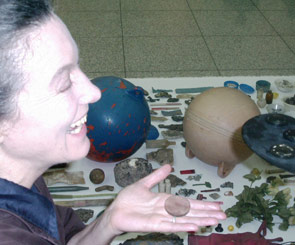
Change is a Law of Nature, Cheongju City Art Gallery during the opening of the Nine Dragonheads Environment Arts Festival, 2004. |
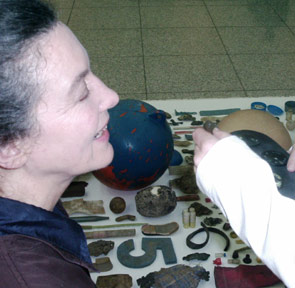
Change is a Law of Nature, |
Johannes:
What exactly is an auxiliary currency? ...and it can't be money if it's auxiliary
to money. So what is the auxiliary factor? |